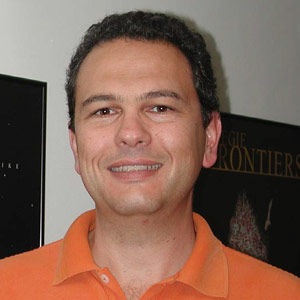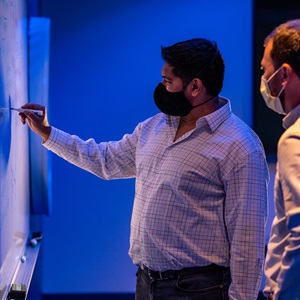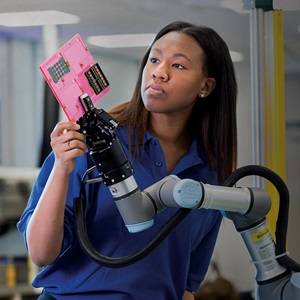Applying AI to Systems Thinking
Every Engineer Has a Story

By Albert McKeon
Everyone has a story to tell, even engineers and systems they build. While there’s no surprise that it’s complex work to design intricate and integrated systems and structures, many may not see that as elements of a bigger picture story.
Using artificial intelligence (AI) to identify and extract those stories can help engineers recognize an approach they've missed or overemphasized. AI can then point them toward creating and refining operational systems more efficiently. That's what two Northrop Grumman developers have discovered: applying AI to systems thinking can bring out the storyteller in every engineer.
“A lot of human activity is a dynamical system, it's a story. Humans are a story telling species. This is a fundamental thing to the way we are built.”
– Isidoros Doxas
Uncovering Dynamics to Revolutionize Engineering
“The way we build things and the way we work is a story,” said Isidoros Doxas, a data scientist at Northrop Grumman. “The current way people engineer is to try to troubleshoot and find failure modes. You have subject matter experts who break things down…then slowly, they come up with a story of how this machine can fail. Failure modes are stories,” Doxas said.
He continued, “The way machine learning works is also a story. Because of that, we have machinery that comes from an analysis of what are dynamical systems. Within this, there are all sorts of points about the life of story, and we can find them.”
By applying machine learning techniques to data sets, Doxas and his team uncover the dynamics that sometimes inconspicuously underlie engineering projects. Their research could revolutionize engineering. The marriage of AI and dynamical systems could, for example, improve the development of fighter planes, targeting systems and communications devices, further advancing the capabilities of a modern military.
“Engineering has a very formalized story technique. It's repeatable, measurable. If anything can lend itself to formalization of this approach it is engineering. It will let engineers pick up a signal out of a lot of noise.”
– Tom Strelich

Isidoros Doxas
Data Scientist

Tom Strelich
Northrop Grumman Fellow
Jumping on the Third Wave
Before coming to Northrop Grumman, Doxas worked as a researcher for nearly two decades at the University of Colorado, Boulder. There, he studied dynamical systems, essentially the backbone of the rule-based models that underpin complex systems. Dynamical systems theory illustrates how systems change over time and the theory doesn't have to be limited to what is considered pure scientific observations.
“A lot of human activity is a dynamical system, it's a story,” he said. “Humans are a story telling species. This is a fundamental thing to the way we are built.” Students at Ohio State University made a life log, using photos taken on their cellphones to catalog the routines of their daily lives. Inevitably, the string of photos showed that their routines formed a dynamical system, he said.
Now at Northrop Grumman — where he develops algorithms, software and computational hardware architectures for AI systems — Doxas has the resources to further pursue his study of dynamical systems.
He also found an ideal collaborator in Tom Strelich, a Northrop Grumman Fellow who specializes in the development of software systems. Strelich is a natural storyteller: He's a playwright, novelist and screenwriter. They and other colleagues are working on what they call the Third Wave AI Dynamical Systems (or TWAI-DS).
“Current AI methods stop at classification, which is useful operationally. We want to push into the next wave of AI with a Dynamical Systems approach,” Strelich said. We want to explore and discover the underlying dynamics behind how people build systems—how they communicate with each other to build the system…. Engineering itself is a structured, formal communication process that people use to design, build and maintain a physical thing, and we tell stories to do that.”
Shifting Engineering "Left"
The first test of TWAI-DS came when Doxas and Strelich applied AI to a collection of 500 fictional short stories; each was 50 paragraphs long, and the first and last paragraphs were identical. The authors had to create a narrative that would mesh their 48 paragraphs with the bookend paragraphs. Despite the differences in the middle, TWAI-DS recognized a pattern, something to consider if the stories were aimed at developing something.
"It showed there is a formula here," Strelich said. "Could it be one that predicts an engineering system? Well, they are just fiction stories, so, 'no.' but… there was an underlying dynamical system, that may be applicable to engineering ‘stories’ too” Strelich said
Leveraging Northrop Grumman intellectual property, TWAI-DS now churns through engineering materials, essentially training itself and building a foundation that "we think will reveal the structure and cognitive dynamics of how humans create and refine mature engineering solutions," Strelich said. The hope is that by applying AI to systems thinking, product and systems development can shift "left"— a point where engineers will see their stories unfolding in real time and can immediately glean insight that benefits projects.
AI Identified Stories Inform Engineering, which Could Shape Modern Military Communications
Strelich likens TWAI-DS to a self-teaching hammer. "Imagine the hammer learning how to be a hammer while being used by a master carpenter. When the hammer is handed to an apprentice carpenter, it knows the difference between a nail and a screw, and how not to bend a nail or smash a thumb."
The insights revealed by TWAI-DS could lead to advancements that create a modern military, sophisticated communication systems and perhaps inventions that haven't yet been considered. "We hope it will attract new clients," Doxas said, "but also enable us to build better things, cheaper and quicker."
"Engineering has a very formalized story technique," Strelich said. "It's repeatable, measurable. If anything can lend itself to formalization of this approach it is engineering. It will let engineers pick up a signal out of a lot of noise."
More innovation stories
Read all stories about advanced technology and innovation >>


